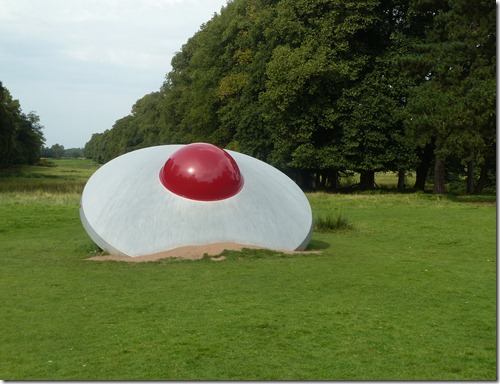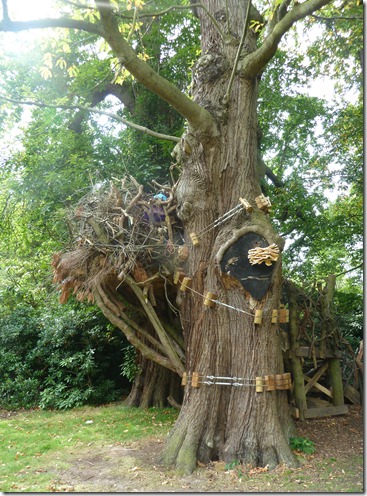We finally got round to visiting the biennial exhibition at Tatton Park on Sunday. It was forecast to be a fine day – after a few days of good weather – and so a good day to get out in the fresh air, get some exercise and look at some art, most of which is outdoors in the park and gardens. The exhibition finishes at the end of September, so this was probably our last chance to see it (at least while the weather was decent). John of “Notes to the Milkman” had been previously and he’s written up his impressions here.
Tatton Hall and its estate used to be the property of the aristocratic Egerton family and was bequeathed to the National Trust in 1958 when the last of the line, Maurice Egerton died unmarried and childless. Although owned by the Trust, the park is run by Cheshire East Council who use it to earn income by hosting over 100 “events” there every year.
Our favourite part of the park are the gardens which include a variety of styles – English, Italian and Japanese. It’s very pleasant to walk around them – although the peace is often disturbed by whatever event happens to be taking place on the adjacent fields and by aircraft flying over at regular intervals. The park is directly below one of the main flight paths for aircraft taking off from the very busy Manchester airport which is only a few miles away. So it was quite apt that the theme for this year’s biennial was flight. There were over 20 exhibits which were being shown in the park, the gardens and inside the neo-classical Mansion house. We’d been to the previous biennial in 2010 and had enjoyed it so wanted to make sure we didn’t miss this year’s exhibition. Although we had to pay a fiver for the car park our National Trust Membership allowed us access to the garden and the Mansion house, otherwise we would have had to shell out another ten quid apiece to see most of the exhibits.
There are a couple of works in the parkland which we could see driving through the grounds to the car park. One, Juneau Projects’ Gleaners of the Infocalypse was half of a BAe 146-200, which, when glimpsed through the trees, seemed as if one of the planes flying over from the airport had crashed in the park.
Just opposite the Mansion house there was an exhibit – VEX by Dinu Li – that was particularly popular with children – a flying saucer that appeared to have crash landed on the lawn.
Walking round the back you could peer inside where there was a video of an actor portraying Che Guevara,
who exists in at least three parallel universes, relate the nature of his crash landing as well as his evolving ideas about the virtues of space flight and dub music as the most effective revolutionary forces at work in the world today.
I’m not sure that the children climbing all over the spaceship while they were watched, aided and abetted by their parents (despite the notices requesting people not to climb on the work which were clearly displayed nearby) would have understood what that was about. I’m not sure I did either, but it was an interesting idea.
Another work that was popular with younger visitors (and, it has to be admitted, adults too) was a giant bird’s nest built on a tree in the formal gardens – Hilary Jack’s Empty Nest.
There were a set of steps so that you could climb up into the nest and get a different perspective of the surrounding woods and garden; a sort of bird’s eye view (at least a nesting bird’s view).
Most of the reviews I’ve read about the exhibition particularly mention Pont de Singe by Olivier Grossetete which can be found on the lily pond. This work was a rickety bridge held up above the water by three large helium filled balloons
It makes quite an impression. There’s something about the large white balloons that’s quite soothing and it fits well into the environment, reflecting in the water. It isn’t static; the helium filled balloons drift around in the wind – although not too far as they’re tethered. On the day we visited it was windy and the balloon and bridge were being blown around like a giant mobile, which added interest to the work and we stood for a while watching it change.
While walking around the pool and the nearby Japanese Garden, the balloons were still visible but showed different aspects with the changing viewpoint.
Nearby, another work, Trine Messenger by Brass Art, a group of three artists, was located on an island further down the lily pond. This was another balloon, this time inflated with fans, in the shape of a head, made using a mean average of the artists’ faces taken from biomedical facial scans. The artists were inspired by classical images of Hypnos, the god of sleep, and the Surrealists.
There were some other works in the gardens but the nest and the two balloons were probably the easiest to relate to. I may return to some of the others in another post.
As with the 2010 biennial, there were a number of works displayed in the Mansion House.
I liked these “three dimensional drawings”, Sarah Woodfine’s ‘Recipe for a kiss of shame’ which was displayed in the Library
The artist was inspired by Tatton’s botanical collections and the information the library houses on Solanaceous, or mind-altering, plants. Her drawings build links between local witches’ covens, botany and potion-making.
The flying connection, then, was with the magical witches’ broom which allowed them to fly – or was it the “mind altering plants” which, when consumed, gave them hallucinations that made them believe that they were flying. One of the reason it appealed to me was that I’ve just finished reading Jeanette Winterson’s new novel “The Daylight Gate” about the Pendle witches.
My favourite work in the Mansion, and probably in the whole exhibition, was Cosmic Cloud by Tessa Farmer. This is a kind of science fiction mobile representing aliens travelling through space towards the Earth.
According to her website
“Tessa’s miniscule sculptures reinvigorate a belief in fairies: not the sweet Tinkerbell image in popular conscience, but a biological, entomological, macabre species translating pastoral fable into nightmarish lore. Constructed from bits of organic material, such as roots, leaves, and dead insects, each of Tessa’s figures stand barely 1 cm tall, their painstakingly intricate detail visible only through a magnifying glass.
And the write up on Cosmic Cloud on the biennial website tells is that in this work her
fairies have their eyes on new planets – they have modified a chimpanzee skull as a space station and they’re using polyps (gas-filled bladders) from Portuguese Man o’ Wars as space pods. In their quest for a new home, they encounter some of the animals we have sent into space – from fruit flies and worms to chimps and dogs.
They’re flying through a cloud of space junk, from artificial satellites and spaceships sent from earth and which orbit our planet.
There are spotlights shining on the mobile reflecting light off the objects and creating interesting shadows on the wall. I’ve seen and enjoyed a number of works over the last few years that employ light and shadows in similar ways. Unfortunately my photograph really doesn’t do it justice.
Overall it was an interesting exhibition and definitely worth the trip – although I’m not sure that I’d have been happy forking out another £20 for the two of us if we didn’t have our NT memberships (I’m beginning to sound like a grumpy old man!). I didn’t like everything, but why should I? Contemporary art is about experimenting and trying new things. Without that, art would stagnate. Not everything is going to work or, indeed, appeal to everyone. But it’s important for visitors to go along with open eyes and, more importantly, open minds.
Postscript
I’ve found a couple of Pinterest “boards “ with images from the exhibition. The first has a number of pictures showing concept sketches made by the artists and photographs taken while exhibits were being installed
http://pinterest.com/artspotter/tatton-park-biennial/
http://pinterest.com/artspotter/preview-of-tatton-park-biennial-2012/









